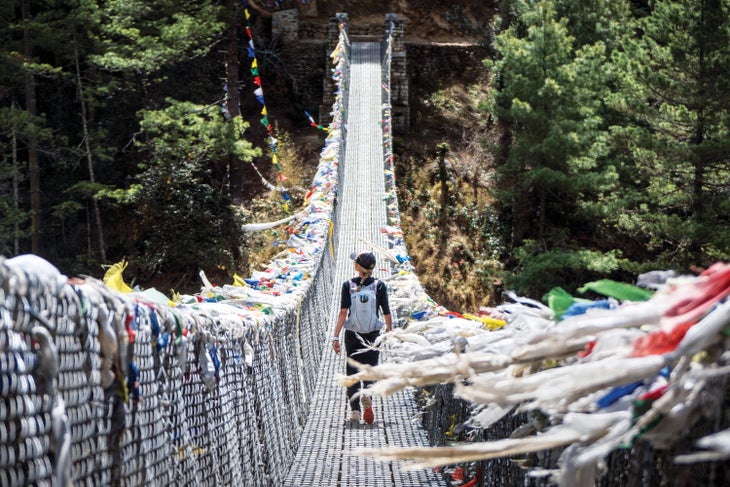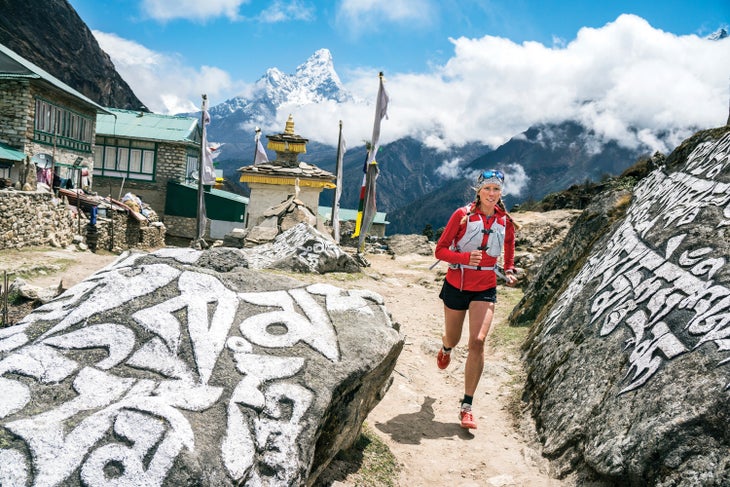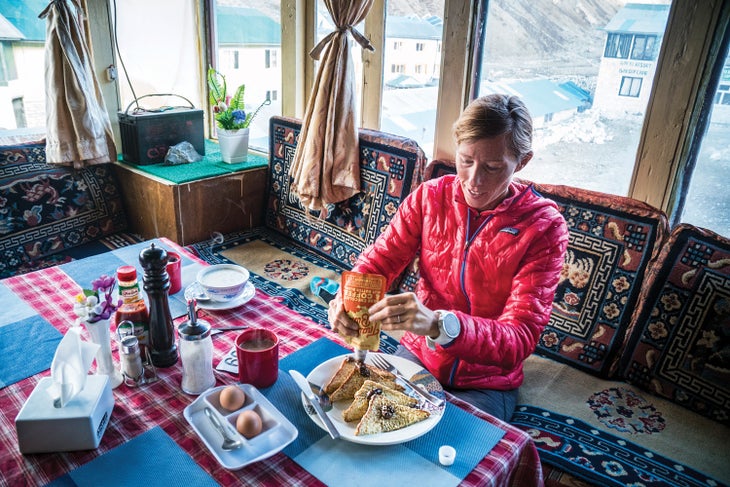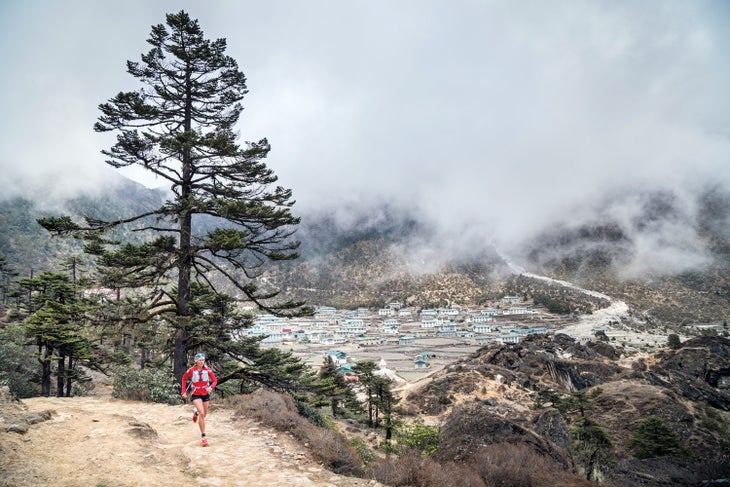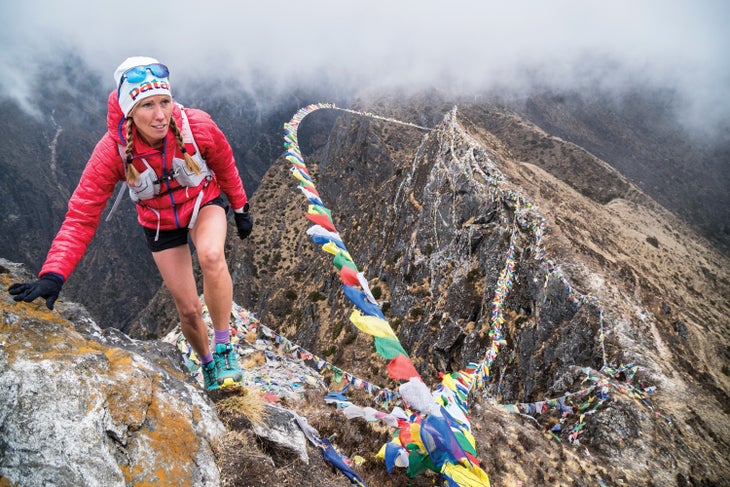New perk! Get after it with local recommendations just for you. Discover nearby events, routes out your door, and hidden gems when you sign up for the Local Running Drop.
By this time, we can’t have more than five miles to go. We’re over all three passes and nearing Namche, the end of our route. We should have cruised into the finish hours ago, but I have to stop and puke again.
Running the 3 Passes Trail is what drew Dan Patitucci and me to the Khumbu. For Dan, a hardened outdoor-sports photographer, of Interlaken, Switzerland, it’s his eighth time to Nepal’s Himalaya. For me, an avid trail runner, but comparatively a puppy when it comes to big mountains, it’s my first. He often comes up with these schemes, projects, objectives, things to teach me, and I’m typically game to go along with the experience. That’s how the relationship works, and how we ended up running in Nepal.
Nepal is famously home to some of the world’s best trails. Icons like the Everest Base Camp trek and Annapurna Circuits have become crowded highways of backpacks and donkey piss. Wanting a quieter route to run, we decided on a route Dan’s had in mind for a while, the Khumbu’s 3 Passes: Renjo La, Cho La and Kongma La. The 38-mile route crosses the main traffic thoroughfares, but avoids the yak-trampled tracks and busiest villages, passing above 17,000 feet three times for spectacular views of the high peaks: Everest, Cholatse, Lhotse, Nuptse and Ama Dablam. But first we have to get there. After a couple of cramped flights, stopovers in Kathmandu and Namche, some extra days of running, a week-long acclimatization trek to the run start and a few more days running and resting, our goal is to run the route back to Namche in a day.
“Try?” Dan asks. The blades spin this time, and we lift up slowly, hovering just above the trees and just below the clouds that grounded all airplane flights for the day.
Landing in Lukla, we snatch our bags and dodge through the blur of airport spectators, cows, yaks and uneven stone steps. It’s all a jumble. I’m only watching my feet. People and animals, moving, carrying, even the air doesn’t sit still. Wind lifts the dust from the trails.
We pass through the archway that marks the entry to Sagarmatha National Park, and begin our two-day walk to Namche (3,440 meters / 11,290 feet). Dan curses the reeking puddles of donkey piss every other step. Countless Himalayan expeditions have started the same way, possibly with some of the same cursing, and we follow in their footprints.
Our plan, reach Namche, spend a few days running, hike to Chukhung via a similar but easier and shorter route, spend a few more days running near Chukhung, then return to Namche on the 3 Passes Trail. The schedule allows us time to acclimatize before the run, and lets me see more of Nepal, tag a few peaks and stop to look around more than if we only rushed through.
Stacks of singing bowls; piles of knock-off gear; the jumble of backpackers where our trail intersects the highway to Everest Base Camp; rocky ridges dancing with prayer flags; stupas and guest houses—all reasons for a first-time visitor, or a returning veteran, to take some extra time to get to the start.
It isn’t often we intersect the busier trails, but when we do, the hikers have to ask, “Everest Marathon?” Training for the mostly downhill race from Everest Base Camp is the only logical explanation that we’re not trudging along with bigger packs.
“No, just running,” we reply with smiles as we dodge through the trekkers sporting glacier goggles and giant boots. We’re a curiosity only rationalized by racing. Running to run seems a foreign concept, more baffling than squat toilets or eating dal bhat with your fingers, and dealing with both those things in a place without running water. We aren’t preparing for competition. We’re simply running today to experience the Himalaya, although the acclimatizing part of it helps.
We leap-frog a Frenchman on the trail, another runner. “Run up to the second house on the right,” he says, enthusiastically. “The woman there makes the best momos. It’s a hard climb, but I’d run up this twice to eat them.” He trots off in huge headphones, topless and in a pair of knock-off Nike sweats.
Today we run a loop above Khumjung across a ridge in mist and fog. On the way back down, something huge and iridescent flies past—a colorful blood pheasant, red and cerulean skimming the treetops. We wind through the grazing yaks, back to the village, and wring our sweaty laundry in the fountain with the locals. We meet the running Frenchman again in the street, and learn of his plans to run 3 Passes, just like us.
When it’s time to leave Namche, we spend five days walking to Chukhung via the village of Gokyo and numerous detours, gaining elevation each day. We’ll have another four days running and resting once we arrive. The walk gives us the chance to scope out the conditions on Cho La, hiking over the middle of the three passes before running back over it on the actual run.
As we make our way higher up the Khumbu valley, I watch the trekkers in the guest houses, hacking, hunched, green. So many look miserable. I am happy not to be miserable, and maybe slightly inflated that I feel good running at 5,000 meters. It can’t be that bad. We aren’t even that high. Dan starts coughing too, but I’m all eagerness.
“What’s it like to run at even higher elevation?” I ask after dinner. Dan lifts the towel he is using to trap the medicinal steam against is face, and grumbles at my giddiness.
“You walk a lot,” he grunts.
And for a few days, we just have to walk—the cold, fever, respiratory infection, miserable-whatever-it-is that Dan caught culminated in him not being able to lift one of his legs. He stops every few meters to sit in pain. I stack his pack on top of mine, and we keep moving and stopping until we reach the Khangri Resort, our base in Chukhung (4730 meters / 15,518 feet). Staggering up the final steps, he asks, “If you have to, will you go alone?”
I’ve already been wondering that during today’s walk. I’m prepared to say that, yes, I will do it, but I’ve already seen how tough it is to navigate the rock glacier between the villages of Thangnak and Gokyo, and how difficult it will be to descend the iced talus coming over Cho La. I already dread those cruxes.
Then I get sick, too. And, yes, it really is that bad.
The irony isn’t lost on either of us. My exhausting enthusiasm is exhausted. As Dan recovers strength and energy on our runs in Chukhung, I deteriorate. Timing couldn’t be worse. We are in our final days of running, resting and waiting for good weather.
3 PASSES INFO
• 60 kilometers / 38 miles from Chukhung (4730m / 15,518ft) to Namche (3440m / 11,286ft)
• 3600 meters or nearly 12,000 feet of elevation gainThe Passes
• Kongma La: 5528 meters / 18,136 feet
• Cho La: 5420 meters / 17,782 feet
• Renjo La: 5360 meters / 17,585 feet
Extra acclimating peaks
• Chukhung Ri 5550 meters / 18,209 feet
• Gokyo Ri 5357 meters / 17,575 feet
When to go:
April through May and after monsoon September through December
Getting there:
From Kathmandu International airport, fly to Tenzing-Hillary Airport, Lukla. The airport in Lukla has only one runway for both taking off and landing. Its runway, at only 527 meters (1,729 feet) long, is known as one of the most dangerous airports in the world. Flights are often delayed or cancelled, but it’s an entertaining place to watch the traffic control. Departures launch off the edge of a cliff and arrivals aim directly at town.
Favorites:
• Sherpa Barista in Namche is worth a stop when you need a really good coffee.
• OR2K in Kathmandu serves fresh food that’s not more dal bhat.
• Khangri Resort, our basecamp in Chukhung.
Finally, 17 days after leaving home, we commit to the run, which begins in Chukhung and ends back in Namche. There is an unexplainable magic in the frozen, morning light in which we start our adventure. We move well, and make it over the first pass, Kongma La, the highest at 5,528 meters / 18,136 feet. Dan provides a welcome surprise, pulling out an entire pizza, neatly folded for portability. I also scarf a whole tube of Oreos. We need all the calories we can get on a run like this.
“No more than 10 minutes here,” we agree, otherwise we won’t want to get going again. I savor the hot ginger-lemon tea, in the now empty room that was crowded a week earlier, and we continue. Tackling the next section over a difficult-to-navigate rock glacier, it’s barely another hour before we arrive in Gokyo.
I don’t want to admit it, but I’m ready to call it quits today. It means letting go of the original goal to do the run in one push, but we’re both still sick and decide to wait until the morning to finish.
In the morning, we move slower up the final pass, but keep a steady pace. When we begin the descent, I’m suddenly unable to run more than a few steps without retching. I kneel and heave. For hours, we move forward like this. Slow, painful, disappointed.
But I don’t want to stop. We’re in Nepal. We’ve already gone over the three high passes, and it’s only downhill left to Namche. There’s no reason not to keep moving, at least between the puking stops. I really don’t want to miss the experience, even like this. I want to know what happens along the way. I want to feel what’s in between: the challenges, the details, the joy and just what it’s like to push your body at high altitude. German-monking.
When the run gets hard, neon-egg-yolk-colored-vomit-from-altitude-sickness hard, Khumbu-cough hard and one-leg-won’t-move-maybe-we-should-we-call-a-helicopter hard, we still can’t help but appreciate the place we are, and what we are doing. Even when running is more of a hobble, there’s plenty to appreciate.
Although it felt forever away, Namche is suddenly, almost too soon, just below us.
